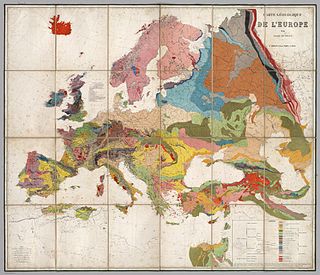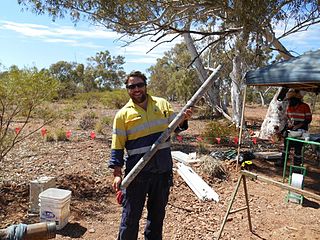The Oregon State Board of Geologist Examiners (OSBGE) is an agency of the U.S. state of Oregon. Administrative support for the board is provided by the Oregon Department of Consumer and Business Services.

In the United States, a state is a constituent political entity, of which there are currently 50. Bound together in a political union, each state holds governmental jurisdiction over a separate and defined geographic territory and shares its sovereignty with the federal government. Due to this shared sovereignty, Americans are citizens both of the federal republic and of the state in which they reside. State citizenship and residency are flexible, and no government approval is required to move between states, except for persons restricted by certain types of court orders. Four states use the term commonwealth rather than state in their full official names.

Oregon is a state in the Pacific Northwest region on the West Coast of the United States. The Columbia River delineates much of Oregon's northern boundary with Washington, while the Snake River delineates much of its eastern boundary with Idaho. The parallel 42° north delineates the southern boundary with California and Nevada. Oregon is one of only three states of the contiguous United States to have a coastline on the Pacific Ocean.

The Oregon Department of Consumer and Business Services (DCBS) is the agency of the government of the U.S. state of Oregon, which has wide-ranging regulatory and consumer-protection authority in Oregon. It administers laws and rules governing workers' compensation benefits, workplace safety and health, building codes, and the operation of both insurance companies and financial institutions.
The mission of the Oregon State Board of Geologist Examiners is to help assure the safety, health, and welfare of Oregonians with regard to the public practice of geology through:

Geology is an earth science concerned with the solid Earth, the rocks of which it is composed, and the processes by which they change over time. Geology can also include the study of the solid features of any terrestrial planet or natural satellite such as Mars or the Moon. Modern geology significantly overlaps all other earth sciences, including hydrology and the atmospheric sciences, and so is treated as one major aspect of integrated earth system science and planetary science.
- Licensing of those engaged in the public practice of geology
- Response to complaints from the public and members of the profession
- Public education directed at appropriate regulatory communities
- Cooperation with closely related Boards and Commissions
- Attention to ethics
- Systematic outreach to counties, cities, and registrants
The Governor of Oregon appoints members of the Oregon State Board of Geologist Examiners. The board consists of four geologists and one public member. The Governor may remove any member of the board for misconduct, incompetence, neglect of duty, or any other sufficient cause.

The Governor of Oregon is the head of the executive branch of Oregon's state government and serves as the commander-in-chief of the state's military forces. The title of governor was also applied to the office of Oregon's chief executive during the provisional and U.S. territorial governments.

A geologist is a scientist who studies the solid, liquid, and gaseous matter that constitutes the Earth and other terrestrial planets, as well as the processes that shape them. Geologists usually study geology, although backgrounds in physics, chemistry, biology, and other sciences are also useful. Field work is an important component of geology, although many subdisciplines incorporate laboratory work.
Each member of the board is a citizen of the United States. The member is also required to have been a resident of Oregon for one year preceding appointment. Insofar as possible, the board is composed of members having diverse geological specialties, including at least one engineering geologist.

The United States of America (USA), commonly known as the United States or America, is a country comprising 50 states, a federal district, five major self-governing territories, and various possessions. At 3.8 million square miles, the United States is the world's third or fourth largest country by total area and is slightly smaller than the entire continent of Europe's 3.9 million square miles. With a population of over 327 million people, the U.S. is the third most populous country. The capital is Washington, D.C., and the largest city by population is New York City. Forty-eight states and the capital's federal district are contiguous in North America between Canada and Mexico. The State of Alaska is in the northwest corner of North America, bordered by Canada to the east and across the Bering Strait from Russia to the west. The State of Hawaii is an archipelago in the mid-Pacific Ocean. The U.S. territories are scattered about the Pacific Ocean and the Caribbean Sea, stretching across nine official time zones. The extremely diverse geography, climate, and wildlife of the United States make it one of the world's 17 megadiverse countries.

Engineering geology is the application of the geology to engineering study for the purpose of assuring that the geological factors regarding the location, design, construction, operation and maintenance of engineering works are recognized and accounted for. Engineering geologists provide geological and geotechnical recommendations, analysis, and design associated with human development and various types of structures. The realm of the engineering geologist is essentially in the area of earth-structure interactions, or investigation of how the earth or earth processes impact human made structures and human activities.
A member of the board holds office until the expiration of the term for which appointed or until their successor has been appointed. Board members are appointed for a term of three years. No person shall serve as a member of the board for more than two consecutive three-year terms.
The State Geologist is an ex officio member of the board.

The Oregon Department of Geology and Mineral Industries (DOGAMI) is the agency of the government of the U.S. state of Oregon responsible for collecting, maintaining and disseminating geologic information, and regulation of industries which commercially develop the state's geological resources, including Natural gas, Crude oil, and other Mineral exploration and Mining.
Geology registration in Oregon was signed into law on July 21, 1977 by Governor Bob Straub. The signed registration bill (House Bill 2288) became law in October 1977. The registration act included registration of Geologists In Training (GIT), Registered Geologists (RG), and Certified Engineering Geologists (CEG). Grandparenting was initially established for one year in 1978, after that testing of qualified applicants was required.

The Governor of Michigan is the chief executive of the U.S. state of Michigan. The current governor is Gretchen Whitmer, a member of the Democratic Party, who was inaugurated on January 1, 2019, as the state's 49th governor. She is eligible for a second term under Michigan's term limits, which limit a governor to only two, four-year terms.
The European Union Intellectual Property Office, founded in 1994, is the European Union Agency responsible for the registration of the European Union trade mark (EUTM) and the registered Community design (RCD), two unitary intellectual property rights valid across the 28 Member States of the EU. Every year, it registers an average of 135 000 EU trade marks and close to 100 000 designs. The EUIPO is also responsible for maintaining an Orphan Works Registry. Registered works have certain permitted acts under the Orphan Works Directive.
Regulation and licensure in engineering is established by various jurisdictions of the world to encourage public welfare, safety, well-being and other interests of the general public and to define the licensure process through which an engineer becomes authorized to practice engineering and/or provide engineering professional services to the public.

The Massachusetts General Court is the state legislature of the Commonwealth of Massachusetts. The name "General Court" is a hold-over from the earliest days of the Massachusetts Bay Colony, when the colonial assembly, in addition to making laws, sat as a judicial court of appeals. Before the adoption of the state constitution in 1780, it was called the Great and General Court, but the official title was shortened by John Adams, author of the state constitution. It is a bicameral body. The upper house is the Massachusetts Senate which is composed of 40 members. The lower body, the Massachusetts House of Representatives, has 160 members. It meets in the Massachusetts State House on Beacon Hill in Boston.

The State Bar of California is California's official attorney licensing agency. It is responsible for managing the admission of lawyers to the practice of law, investigating complaints of professional misconduct, and prescribing appropriate discipline. It is directly responsible to the Supreme Court of California. All attorney admissions and disbarments are issued as recommendations of the State Bar, which are then routinely ratified by the Supreme Court.

The Alabama Legislature is the legislative branch of the state government of Alabama. It is a bicameral body composed of the House of Representatives and Senate. It is one of the few state legislatures in which members of both chambers serve four-year terms and in which all are elected in the same cycle. The most recent election was on November 6, 2018. The new legislature assumes office immediately following the certification of the election results by the Alabama Secretary of State which occurs within a few days following the election.

The National Council of Architectural Registration Boards (NCARB) is a nonprofit corporation comprising the legally constituted architectural registration boards of the 50 states, the District of Columbia, Guam, Puerto Rico, and the U.S. Virgin Islands as its members. Its mission is to protect the public health, safety, and welfare by leading the regulation of the practice of architecture through the development and application of standards for licensure and credentialing of architects.
The Southeast Louisiana Flood Protection Authority was established by Louisiana state law Revised Statute §38:330.1 in September 2006. Its operation began in January 2007. The Authority consists of two regional levee boards which oversee flood protection in the Greater New Orleans area on the east and west banks of the Mississippi River. Commissioners of both Authorities have clearly defined term limits. The Authority also has a Nominating Committee.

The Secretary of State of the State of Oklahoma is the chief clerical officer of Oklahoma and a member of the Oklahoma Governor's Cabinet. The Secretary of State is the only appointed constitutional member of the executive branch of the Oklahoma state government. The office of Secretary of State was elective from statehood until 1975 when the Constitution was amended and it became an appointive office, running concurrent with the Governor effective in 1979.

The government of the U.S. State of Oklahoma, established by the Oklahoma Constitution, is a republican democracy modeled after the federal government of the United States. The state government has three branches: the executive, legislative, and judicial. Through a system of separation of powers or "checks and balances," each of these branches has some authority to act on its own, some authority to regulate the other two branches, and has some of its own authority, in turn, regulated by the other branches.

The Oregon Attorney General is a statutory office within the executive branch of the state of Oregon, and serves as the chief legal officer of the state, heading its Department of Justice with its six operating divisions. The Attorney General is chosen by statewide partisan election to serve a term of four years. The incumbent, Ellen Rosenblum, was sworn in on June 29, 2012, replacing John Kroger, a Democrat who was elected in 2008 and resigned six months before the end of his term to become President of Reed College. She was re-elected in 2016.

The Professional Regulation Commission, otherwise known as the PRC, is a three-man commission attached to Department of Labor and Employment (DOLE). Its mandate is to regulate and supervise the practice of the professionals who constitute the highly skilled manpower of the country. As the agency-in-charge of the professional sector, the PRC plays a strategic role in developing the corps of professionals for industry, commerce, governance, and the economy.

The Oklahoma State Election Board is the governing body regarding elections in the state of Oklahoma. The Board is responsible for maintaining uniformy in the application, operation and interpretation of State and Federal election laws. Additionally, the Board is responsible for promoting and encouraging the citizens of Oklahoma to register to vote and participate in all elections by providing educational programs to raise citizen awareness about voting privileges and about the services available to them.
The government of Indiana is established and regulated by the Constitution of Indiana. The state-level government consists of three branches, the judicial branch, the legislative branch, and the executive branch. The three branches share power and jointly govern the state of Indiana. County and local governments are also constitutional bodies with limited authority to levy taxes, pass legislation, and create and maintain local public infrastructure.

The government of the U.S. state of Kansas, established by the Kansas Constitution, is a republican democracy modeled after the Federal Government of the United States. The state government has three branches: the executive, the legislative, and the judicial. Through a system of separation of powers, or "checks and balances," each of these branches has some authority to act on its own, and also some authority to regulate the other two branches, so that all three branches can limit and balance the others' authority.
The Oregon State Bar (OSB) is a government agency in the U.S. state of Oregon. Founded in 1890 as the private Oregon Bar Association, it became a public entity in 1935 that regulates the legal profession. The public corporation is part of the Oregon Judicial Department. Lawyers are required to join the OSB in order to practice law in Oregon.

The Institution of Engineers Australia, often shortened to IEAust and/or trading as Engineers Australia (EA), is a professional body and not-for-profit organisation dedicated to being the national forum for the advancement of the engineering field within Australia and a member of Washington Accord. As of 2017, it has around 100,000 members in nine geographic Divisions and five international chapters from all engineering disciplines, including 41,000 Students, 4,400 Engineering Technologists and Engineering Associates, 55,600 Professional Engineers. The members all belong to one or more of nine Colleges covering the different fields of engineering practice. 20,000 members are Chartered Engineers.
Professional requirements for architects vary from place to place, but usually consist of three elements: a university degree or advanced education, a period of internship or training in an office, and examination for registration with a jurisdiction.
An engineering geologist is a geologist trained in the discipline of engineering geology. Many organizations and governments have programs for the qualification, testing and certification of engineering geologists as a protection to the public.


















